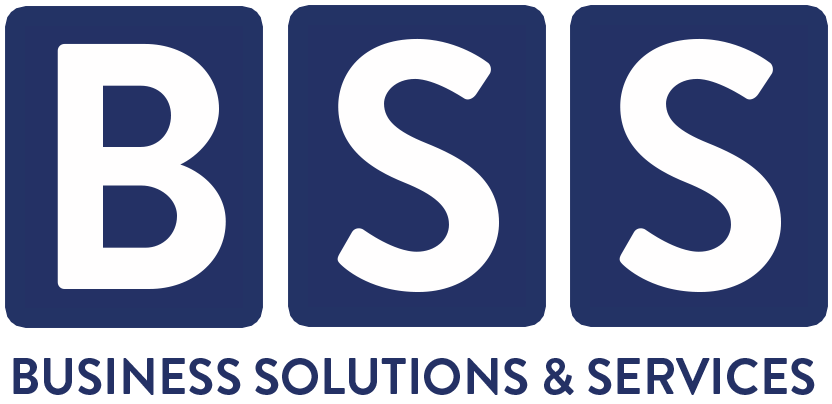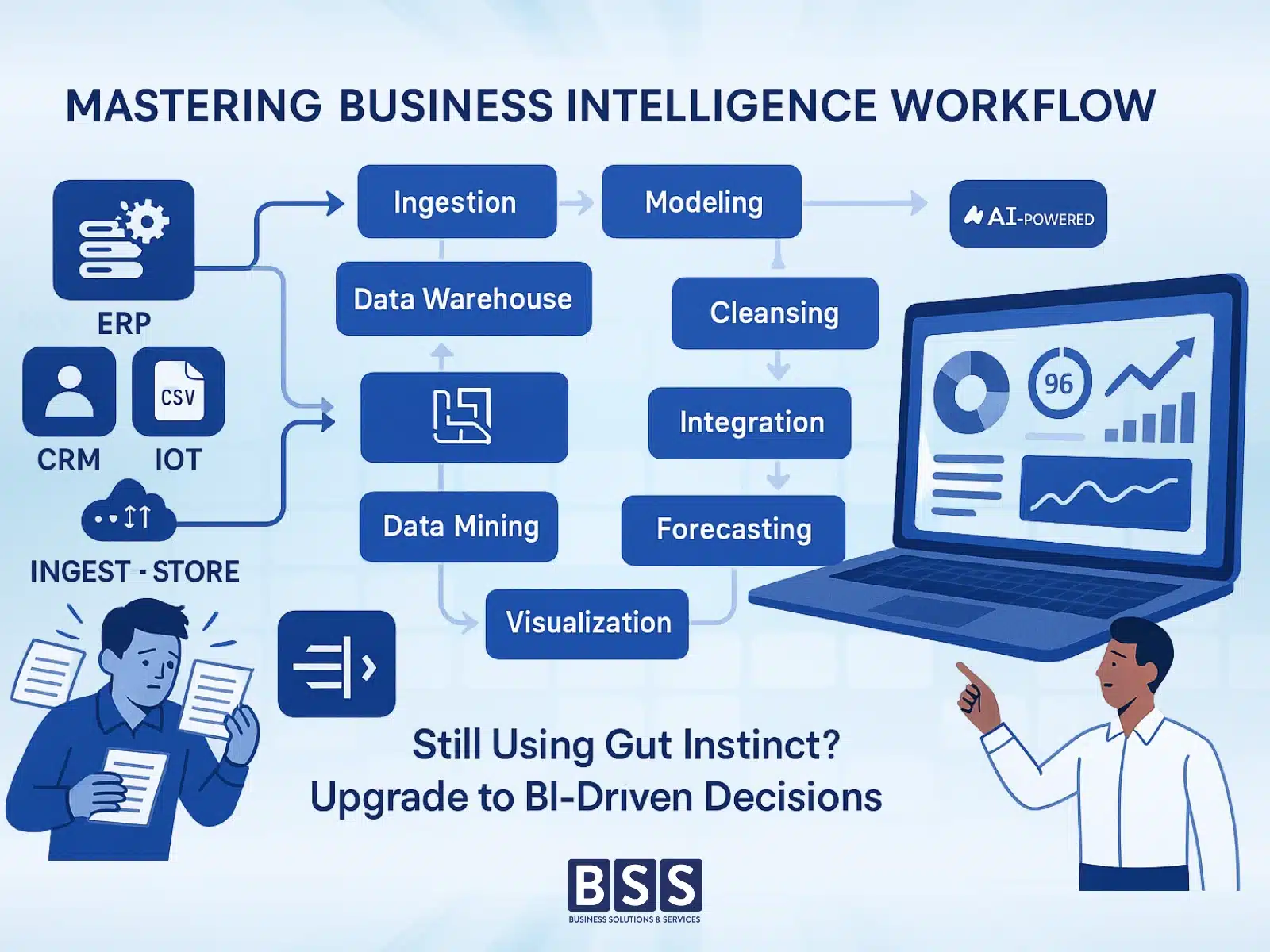In today’s data-driven world, business intelligence is essential—not optional. Whether in healthcare data analytics, retail data analytics, or entry level data science jobs, companies now rely on structured data to improve decisions, reduce risk, and personalize user experiences. Tools like predictive data analytics, data warehousing, and AI-driven dashboards help transform raw information into real insights.
Business Solutions & Services (BSS) leads this shift by offering complete analytics support. From data mining services to AI-enhanced business data analyst tools, BSS delivers scalable frameworks that support everything from junior data analyst jobs to enterprise-level analytics strategy. It’s not just about collecting data—it’s about using it to drive smart, measurable outcomes.
Key Steps in the Business Intelligence (BI) Workflow Using the Abbreviated Qualitative Analysis Scheme
1. Data Ingestion Pipelines
Data ingestion is the first step in the BI journey. It moves raw data from multiple sources—like spreadsheets, APIs, or databases—into one stream for processing. Whether you’re applying for data analytics internships or building systems for data analytics companies, efficient ingestion ensures smooth operations. Companies in healthcare data analytics and retail data analytics rely on solid pipelines to handle real-time and batch data. This foundational step supports reliable reporting, dashboards, and future predictive data analytics.
2. Data Warehousing
Data warehousing involves storing large amounts of structured data in a central repository, making it accessible for analysis and reporting. This is especially important in entry level data analyst careers, where understanding SQL and warehouse tools is often expected. In industries like healthcare, retail, and finance, warehousing ensures consistent, accurate data across departments. Whether you’re a junior data analyst or working remotely in data analytics jobs, mastering warehousing tools boosts performance and decision-making power.
3. Data Modeling
Data modeling shapes how information is organized, helping teams map real-world business logic into databases. It’s critical for roles like business data analyst or entry level data science jobs, where clean structure makes data easier to analyze. Logical models help connect different data points—for example, linking customer behavior with purchase history. In companies focused on data analytics in finance or data analytics in health care, strong models drive better forecasting, reporting, and executive dashboards.
4. Data Cleansing & Transformation
Dirty data leads to wrong decisions. That’s why cleansing and transformation are key in any data analytics entry level job or advanced analytics workflow. Cleansing removes duplicates, fills missing values, and standardizes formatting. Transformation changes how data looks and works—like converting text to dates or dollars. For anyone building a data analytics resume or working on data analytics projects, these steps ensure that insights are reliable, especially in sectors like healthcare or marketing analytics.
5. Data Integration
Data integration pulls information from multiple platforms into a unified view, enabling cross-functional analysis. Whether you’re using tools for data analytics in banking, marketing, or HR analytics, integration ensures smooth, accurate results. Businesses often connect CRM systems, e-commerce platforms, or healthcare records to track customer behavior or patient outcomes. Integration is also critical for data and analytics consulting roles, where decision-makers rely on one source of truth to guide their strategies.
6. Data Mining
Data mining uncovers patterns, relationships, and anomalies hidden in large datasets. This is where junior data analysts or interns in data analytics begin to see the “why” behind the numbers. It’s useful in fields like retail analytics, fraud detection, and even sports data analytics. When used correctly, mining helps businesses predict trends, identify weak points, and boost performance. If you’re building a portfolio or applying to entry level data analyst jobs, hands-on mining projects show strong practical skills.
7. Predictive & Quantitative Analysis
Predictive analysis uses statistical models and historical data to forecast what’s likely to happen next. It’s a skill often found in data analyst entry level jobs, especially in finance, marketing, and healthcare. Quantitative methods like regression, classification, or time series models help analysts answer questions like “What will sales look like next month?” or “Which customers are likely to churn?” Learning tools like Excel, Python, or R adds value to your data analytics resume and builds real-world career impact.
8. Qualitative Analysis
While numbers tell one story, qualitative analysis reveals the “why” behind user actions. Using the Abbreviated Qualitative Analysis Scheme, analysts explore human behavior, context, and motivation in a structured way. This is critical in healthcare data analytics, product research, or UX design. Whether you’re working as a junior data analyst or pursuing data analytics certification, blending qualitative insight with numbers helps create richer, more actionable reports—especially in people-focused industries.
9. Machine Learning
Machine learning uses algorithms that learn from data to make predictions without being manually programmed each time. From entry-level projects to advanced models used by data analytics consultants, machine learning powers everything from recommendation engines to fraud detection systems. If you’re applying for a data science and analytics role or considering an MS in data analytics online, learning ML basics in Python or R can set your resume apart and demonstrate problem-solving with real business impact.
10. Artificial Intelligence
AI takes data analysis further by simulating human thinking and automating decisions. It’s widely used in remote data analytics jobs, chatbots, marketing campaigns, and fraud detection. Companies offering data analytics and business intelligence services often embed AI into their tools to deliver faster, smarter insights. As AI continues to evolve, it’s influencing roles from entry level data analysts to senior data analytics managers. Understanding its application is key for future-proofing your data career.
11. OLAP & OLTP Systems
OLAP (Online Analytical Processing) is used for reporting and analytics, while OLTP (Online Transaction Processing) handles day-to-day operations like order processing or banking transactions. Knowing when to use each system is essential in data analytics jobs in sectors like retail, healthcare, and finance. Whether you’re applying for a part-time data analyst position or working in data analytics strategy, understanding OLAP vs. OLTP helps you design systems that are both fast and reliable.
12. Data Visualization & Dashboards
Data visualization turns complex information into charts, graphs, and dashboards. It’s the skill that helps executives and teams make fast, informed decisions. In entry level data analyst roles or freelance data analytics work, knowing tools like Tableau, Power BI, or Google Data Studio makes your work stand out. Whether you’re building a resume for data analytics, presenting in a boardroom, or supporting remote analytics teams, strong visuals make data easier to understand—and act on.
How BSS Empowers Your BI Journey with the Abbreviated Qualitative Analysis Scheme
Business Solutions & Services (BSS) delivers a complete business intelligence ecosystem—built to turn raw data into real outcomes. From managing data ingestion pipelines to implementing machine learning models, BSS covers every part of the analytics workflow. Their team ensures that each layer, including data integration, cleansing, and visualization, supports smart, real-time decision-making.
Using the Abbreviated Qualitative Analysis Scheme, BSS helps organizations uncover not just numbers but also the human context behind them. With deep experience in data warehousing, AI-powered insights, and data mining services, they make analytics accessible for both entry level data analyst careers and enterprise solutions. Whether you’re in healthcare data analytics, retail, or finance, BSS empowers smarter strategies with data that actually drives action.
Conclusion
Business intelligence is more than dashboards and reports—it’s a complete strategy that drives smarter decisions. By using structured data pipelines, predictive analytics, and the Abbreviated Qualitative Analysis Scheme, companies can achieve a full, real-time view of both operations and customer behavior. These tools support long-term growth, whether you’re in healthcare data analytics, retail, or looking for entry level data analyst jobs.
Working with Business Solutions & Services (BSS) means building a future-ready analytics foundation. With expertise in data warehousing, AI-powered insights, and data mining services, BSS helps turn raw data into meaningful outcomes. From startups to enterprise teams, their scalable BI framework delivers insight, clarity, and performance at every level.
FAQs:
What is the Abbreviated Qualitative Analysis Scheme?
The Abbreviated Qualitative Analysis Scheme is a quick, structured method for analyzing text data. At BSS, it’s used to extract insights from sample qualitative studies, interviews, and feedback—helping improve business intelligence in areas like healthcare analytics and people analytics roles.
How do qualitative research jobs support BI at BSS?
Qualitative research roles at BSS use structured methods, including the Abbreviated Qualitative Analysis Scheme, to uncover the “why” behind numbers. These insights, similar to findings in studies like The Role of Family in Diabetes Management, add context to BI dashboards and drive smarter strategies.
Can a used bookshelf help BI teams at BSS?
Yes. A used bookshelf at BSS stores printed qualitative research, article bookshelf reports, and analysis guides. This physical reference library improves daily analyst workflow, enabling quick access to case studies and boosting data-driven decision-making.
How does qualitative comparative analysis improve BI at BSS?
Qualitative Comparative Analysis (QCA) helps BSS teams understand why similar cases have different outcomes. Combined with the Abbreviated Qualitative Analysis Scheme, it uncovers patterns in customer behavior, benefiting sectors like healthcare analytics and strategic BI planning.
Why does BSS use sample qualitative studies?
Sample qualitative studies help BSS train analysts, explain trends, and validate BI models. They provide real-world examples for entry-level analysts and consultants, enhancing dashboard insights with human context alongside quantitative data.
What is content analysis and how does BSS use it?
Content analysis involves coding and categorizing text to identify themes. At BSS, it’s paired with the Abbreviated Qualitative Analysis Scheme to transform open-ended responses, reviews, and notes into actionable BI insights—especially for healthcare and HR analytics.
Which research design allows cause-and-effect conclusions?
Only experimental research designs confirm cause-and-effect. BSS complements this with Qualitative Comparative Analysis and the Abbreviated Qualitative Analysis Scheme to explain why outcomes occur, merging data with narrative insight.
Why does BSS maintain an article bookshelf?
BSS keeps an article bookshelf stocked with research, internal guides, and study examples. It gives BI teams instant access to cases, the Abbreviated Qualitative Analysis Scheme, and training materials, supporting agile and informed analytics work.
Why are examples of qualitative research important at BSS?
Examples of qualitative research help BSS show how human perspectives shape BI outcomes. From customer feedback to healthcare case studies, these examples guide dashboard design and strengthen strategic decisions.

